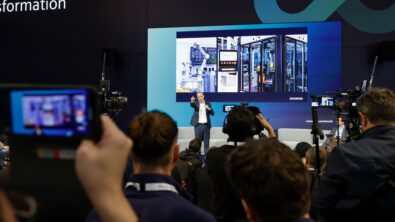Tecnomatix Track Day 2 @ PLM Connection Americas 2012
Recap of Day 2:
Uli Rossgoderer, Director, Product Management kicked off Day 2’s Tecnomatix session with a comprehensive overview of the Assembly Planning solutions. He made it clear that the manufacturing engineering solutions are tightly integrated to product engineering through four key functions: Plan, Validate, Document and Execute.
Keying off some of Chuck Grindstaff’s core messages from Day 1: intelligently integrated information, value added applications, the user experience and system performance, Uli described some of the latest features in the latest release of Tecnomatix, as well as some of the upcoming features destined for future releases.
While attendees at PLM Connection come to hear from the executive team, product managers and technical resources of Siemens PLM Software, the overwhelming value of this conference comes from the customers who take time away from their responsibilities to speak about their use of our digital manufacturing technology. So to all customers who are here supporting the event, hat’s-off and thank you for making every PLM Connection a huge success. Speaking of customers, we were lucky to have Alan Baumgartner, Technical Leader, Virtual Manufacturing for Ford Motor Company, speak about one of the key new features just released, enterprise bill of process. Alan described the pressure and complexity of planning and implementing global production strategies in the way that only Alan can. Describing Ford’s business model for manufacturing as product and process convergence, how standard components and processes across vehicle lines improves commonality which in turn boosts quality, flexibility and efficiency across their production footprint.
Speaking of customers, we were lucky to have Alan Baumgartner, Technical Leader, Virtual Manufacturing for Ford Motor Company, speak about one of the key new features just released, enterprise bill of process. Alan described the pressure and complexity of planning and implementing global production strategies in the way that only Alan can. Describing Ford’s business model for manufacturing as product and process convergence, how standard components and processes across vehicle lines improves commonality which in turn boosts quality, flexibility and efficiency across their production footprint. Next we had Soumyadeep Basak from Honeywell Aerospace describe the implementation of EWI or Engineering Work Instructions as an integrated value-add to their Teamcenter manufacturing environment. Honeywell went through several cycles of testing other solutions to help manage documentation for shop floor processes but each one came with some aspect that required too much manual intervention which increased the risk of non-compliance to regulatory standards. With EWI, Honeywell has virtually eliminated manual intervention, the inefficiencies in having to check if it’s the latest revision and driven an easily deployable solution to their production environment.
Next we had Soumyadeep Basak from Honeywell Aerospace describe the implementation of EWI or Engineering Work Instructions as an integrated value-add to their Teamcenter manufacturing environment. Honeywell went through several cycles of testing other solutions to help manage documentation for shop floor processes but each one came with some aspect that required too much manual intervention which increased the risk of non-compliance to regulatory standards. With EWI, Honeywell has virtually eliminated manual intervention, the inefficiencies in having to check if it’s the latest revision and driven an easily deployable solution to their production environment.
After lunch, we kicked-off an afternoon focused on our quality solutions.
Al Hufstetler, VP, Product Management described our strategies in this space and the explicit value that PLM based quality delivers. Al described some research done by the Boston Consulting Group about a gap that many companies face between the expected value and the actual value of a new product launch. By far, the largest contributor to this gap is design and manufacturing quality.Al made the point that quality and PLM brings the design and manufacturing domains together in the most effective way possible in order to address this gap. Next we heard from Matt Taylor from Raytheon Missile Systems. Raytheon has very complex issues to overcome when designing and manufacturing these systems. Model check in CAD solutions isn’t enough.Tolerance check on the design isn’t enough. They’re utilizing every millimeter inside these weapons and they know that variation introduced in manufacturing can cause major issues.So Matt described how Variation Analysis (VSA) is helping Raytheon to design more robust components and eliminate issues on the shop floor. He went on to describe how Raytheon is also using Process Simulate to ensure manufacturability by simulating the assembly process in these very confined spaces.
Next we heard from Matt Taylor from Raytheon Missile Systems. Raytheon has very complex issues to overcome when designing and manufacturing these systems. Model check in CAD solutions isn’t enough.Tolerance check on the design isn’t enough. They’re utilizing every millimeter inside these weapons and they know that variation introduced in manufacturing can cause major issues.So Matt described how Variation Analysis (VSA) is helping Raytheon to design more robust components and eliminate issues on the shop floor. He went on to describe how Raytheon is also using Process Simulate to ensure manufacturability by simulating the assembly process in these very confined spaces. Our final customer of the day was Lori Russell from GM. Lori’s presentation described the implementation of a global system for managing build quality, a first in the industry. This is significant and the importance was not lost on the audience as she described how over 60 production facilities, GM and JV plants, are now flowing as-built dimensional quality information through our DPV solution. Replacing about 15 unique solutions which made it very difficult to see and compare production quality between vehicle platforms and plants, GM now has the ability to see quality from any plant, on any program, from anywhere in the world. DPV gives GM design and assembly engineers the critical insight they need to fix quality issues faster and identify their best quality processes which can then be implemented across the globe. They currently have three thousand users and expect to double that amount very quickly. According to Lori, this is GM’s one-stop shopping, problem solving solution which is helping GM to continually improve their world class quality across the world.
Our final customer of the day was Lori Russell from GM. Lori’s presentation described the implementation of a global system for managing build quality, a first in the industry. This is significant and the importance was not lost on the audience as she described how over 60 production facilities, GM and JV plants, are now flowing as-built dimensional quality information through our DPV solution. Replacing about 15 unique solutions which made it very difficult to see and compare production quality between vehicle platforms and plants, GM now has the ability to see quality from any plant, on any program, from anywhere in the world. DPV gives GM design and assembly engineers the critical insight they need to fix quality issues faster and identify their best quality processes which can then be implemented across the globe. They currently have three thousand users and expect to double that amount very quickly. According to Lori, this is GM’s one-stop shopping, problem solving solution which is helping GM to continually improve their world class quality across the world.
Thanks you all of you who helped may Day 2 a success.


